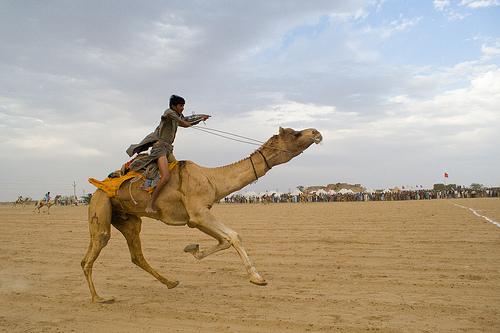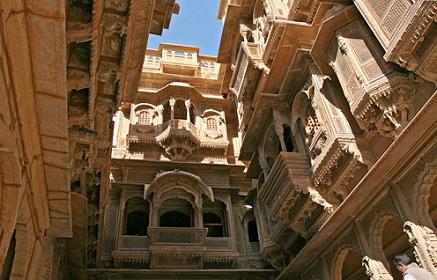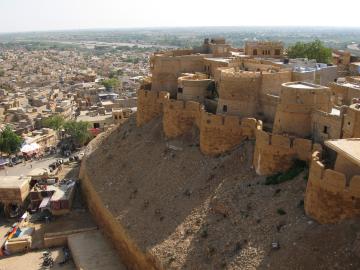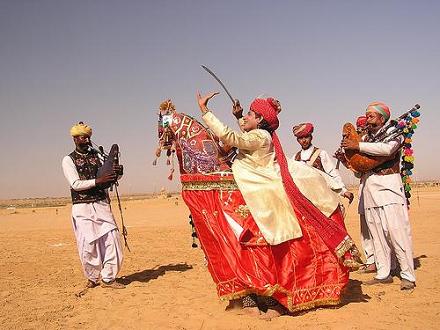
All About Famous In jaisalmerDesert Festival jaisalmer  Desert Festival of jaisalmer is a colorful festival held in February every year. You will get to see Cultural events, camel races, turban tying competitions etc. Not exciting enough! Attend the contests to judge the man with the best moustache. Everything is exotic in the Desert festival, amidst the golden sands of the Thar Desert. With a final musical performance by folk singers under the moonlit sky at the dunes in Sam, just outside jaisalmer, the festival comes to its end. The rich culture of the region is on display during this three daylong extravaganza.
Desert Festival is the best showcase, one can ever want to view the rich and colorful and rich culture of the desert region of Rajasthan. The major attractions of the festivals are Gair and Fire dancers who wear vibrant and brightly colored costumes as they dance and sing and perform on the regional tunes that are mainly based on the ballads of tragedy, valor, and romance of the local heroes. Along with these folk performers are snake charmers, puppeteers, and acrobats. The ship of the desert camels, of course earn their special place in the festival and camel rides are quite popular here. Camel polo and camel dance are two unique feature events of the fair just as the turban tying competition and display of the most glorious moustaches. The thing to note here is that turbans and mustaches are considered symbols of honor in the region. There is also a Mr. Desert contest that further enhances the fun of the occasion.
The desert festival in jaisalmer was started to attract foreign tourists, who always wanted to explore as many facets of Rajasthan as they could in the possible crunch of time. The three-day event stresses more on local elements and heritage. For example, this no-nonsense festival will only showcase Rajasthani folk songs and dance. These are presented by some of the best professionals of the art. Similarly, local customs such as Turban tying etc have been added to make it more exotic and colorful in its outlook. 'The moustache competition' is very popular among foreigners. This is simply because of the surprise value attached to this event. Foreigners can be seen posing for pictures with the winners. This is truly a moment worth preserving.
The Desert Festival is one of the most popular cultural events on the annual festival calendar of Rajasthan. The colorful event is held every year at jaisalmer in the months of January/February. The festival is a showcase of the performing arts and crafts of Rajasthan. The melodious tunes and rhythms of the folk musicians and amazing folk dance performances by renowned artists create a spellbound effect on spectators. The event is organized on the famous golden sand dunes at Sam near jaisalmer. Colorful craft bazaars set up for the occasion are an added attraction of the festival.
Many exciting competitions are held during this colorful event. Camel races, the turban-tying contest, Mr. Desert contest and a contest for the longest moustache add more color and charm to this cultural extravaganza. The colorfully decorated camels take you to the beautiful sand dunes in the nearby regions. While in jaisalmer, you can also visit the famous mansions and forts of jaisalmer. A visit to jaisalmer Fort, Patwon - ki - Haveli and Gadsisar Lake among many more can be a rewarding experience for you.
Camel and horse sports, healthy competitions, traditional cuisine, ethnic craft stalls and a wide variety of colorful desert paraphernalia greet you on your jaisalmer festival tours with Rajasthan Holiday.
The main jaisalmer festival is of course the Desert festival that radiates all that is bright and beautiful about Golden jaisalmer. Celebrated in the month of February every year, the desert festival in jaisalmer draws crowds from far and wide and scintillates with colors of joy and frolic.
We, Fascinating Rajasthan welcome you to this colorful and vibrant region of India. Come and experience the true colors of Rajasthan in its fairs and festivals on your Fascinating Rajasthan Festival Tour. Fascinating Rajasthan is an experienced and trusted tour operator providing excellent services to its customers for many years now.
You will never forget marvels like the famous Gair and Fire dancers that are the major attraction of the desert festival celebrations. Interesting contests including a tying competition and a Mr. Desert contest further enhance the fun of the occasion. A trip to the Sam sand dunes marks the grand finale, where you will enjoy camel rides and brilliant performance by the folk artist under the full moon against the backdrop of picturesque dunes.
The Rajasthan tourism organizes the jaisalmer Desert festival. There is tourist help cell to deal specially with the problems faced by foreign tourists. The arrangements are monitored by local administration and state of the art Medical vans, equipped with the best of medical amenities, are kept on alert. If you want to buy gifts or souvenirs for your dear ones, this is the place to be. For this place not only have items from and around jaisalmer but of the whole Rajasthan. Mobile money exchangers are there in case you need to exchange currencies. And if you run out of cash, Guess what! Nearly all the kiosks have the facility to accept credit card.
Desert Festival of jaisalmer is a colorful festival held in February every year. You will get to see Cultural events, camel races, turban tying competitions etc. Not exciting enough! Attend the contests to judge the man with the best moustache. Everything is exotic in the Desert festival, amidst the golden sands of the Thar Desert. With a final musical performance by folk singers under the moonlit sky at the dunes in Sam, just outside jaisalmer, the festival comes to its end. The rich culture of the region is on display during this three daylong extravaganza.
Desert Festival is the best showcase, one can ever want to view the rich and colorful and rich culture of the desert region of Rajasthan. The major attractions of the festivals are Gair and Fire dancers who wear vibrant and brightly colored costumes as they dance and sing and perform on the regional tunes that are mainly based on the ballads of tragedy, valor, and romance of the local heroes. Along with these folk performers are snake charmers, puppeteers, and acrobats. The ship of the desert camels, of course earn their special place in the festival and camel rides are quite popular here. Camel polo and camel dance are two unique feature events of the fair just as the turban tying competition and display of the most glorious moustaches. The thing to note here is that turbans and mustaches are considered symbols of honor in the region. There is also a Mr. Desert contest that further enhances the fun of the occasion.
The desert festival in jaisalmer was started to attract foreign tourists, who always wanted to explore as many facets of Rajasthan as they could in the possible crunch of time. The three-day event stresses more on local elements and heritage. For example, this no-nonsense festival will only showcase Rajasthani folk songs and dance. These are presented by some of the best professionals of the art. Similarly, local customs such as Turban tying etc have been added to make it more exotic and colorful in its outlook. 'The moustache competition' is very popular among foreigners. This is simply because of the surprise value attached to this event. Foreigners can be seen posing for pictures with the winners. This is truly a moment worth preserving.
The Desert Festival is one of the most popular cultural events on the annual festival calendar of Rajasthan. The colorful event is held every year at jaisalmer in the months of January/February. The festival is a showcase of the performing arts and crafts of Rajasthan. The melodious tunes and rhythms of the folk musicians and amazing folk dance performances by renowned artists create a spellbound effect on spectators. The event is organized on the famous golden sand dunes at Sam near jaisalmer. Colorful craft bazaars set up for the occasion are an added attraction of the festival.
Many exciting competitions are held during this colorful event. Camel races, the turban-tying contest, Mr. Desert contest and a contest for the longest moustache add more color and charm to this cultural extravaganza. The colorfully decorated camels take you to the beautiful sand dunes in the nearby regions. While in jaisalmer, you can also visit the famous mansions and forts of jaisalmer. A visit to jaisalmer Fort, Patwon - ki - Haveli and Gadsisar Lake among many more can be a rewarding experience for you.
Camel and horse sports, healthy competitions, traditional cuisine, ethnic craft stalls and a wide variety of colorful desert paraphernalia greet you on your jaisalmer festival tours with Rajasthan Holiday.
The main jaisalmer festival is of course the Desert festival that radiates all that is bright and beautiful about Golden jaisalmer. Celebrated in the month of February every year, the desert festival in jaisalmer draws crowds from far and wide and scintillates with colors of joy and frolic.
We, Fascinating Rajasthan welcome you to this colorful and vibrant region of India. Come and experience the true colors of Rajasthan in its fairs and festivals on your Fascinating Rajasthan Festival Tour. Fascinating Rajasthan is an experienced and trusted tour operator providing excellent services to its customers for many years now.
You will never forget marvels like the famous Gair and Fire dancers that are the major attraction of the desert festival celebrations. Interesting contests including a tying competition and a Mr. Desert contest further enhance the fun of the occasion. A trip to the Sam sand dunes marks the grand finale, where you will enjoy camel rides and brilliant performance by the folk artist under the full moon against the backdrop of picturesque dunes.
The Rajasthan tourism organizes the jaisalmer Desert festival. There is tourist help cell to deal specially with the problems faced by foreign tourists. The arrangements are monitored by local administration and state of the art Medical vans, equipped with the best of medical amenities, are kept on alert. If you want to buy gifts or souvenirs for your dear ones, this is the place to be. For this place not only have items from and around jaisalmer but of the whole Rajasthan. Mobile money exchangers are there in case you need to exchange currencies. And if you run out of cash, Guess what! Nearly all the kiosks have the facility to accept credit card.
jaisalmer Havelis  Patwon ki Haveli
Patwon ki HaveliIt is one of the most engrossing and elaborate haveli in the dusty dunes of jaisalmer, build by wealthy merchant Guman Chand Patwa, who used to owns more than three hundred trading centers from Afghanistan to China. The haveli comprises of 5 storey building, courtyard and some of it roofs are now used as bustling shops, where you can look for original Rajasthani crafts, mirror work and miniature paintings. Factroid Do you know Guman Chand Patwa the owner of Patwon ki Haveli was the wealthy merchant of that time, who used to own more than three hundred trading centers from Afghanistan to China.A tourist must pay visit at the rooftop for dazzling view of the golden city and delicately chiseled balconies, where the motes of dust dance on the beam of light. This enchanting haveli is located near the City Center of jaisalmer, from where the tourists can hire taxis, local buses, rickshaw and tongas to access Patwon Ki Haveli. Salim Singh Ki Haveli Salim Singh was serving jaisalmer as a Prime Minister, in the time when jaisalmer was the capital of princely state. It is one of the most alluring haveli ever constructed in the history of jaisalmer, build in 1815 A.D. As you enter this bewitching haveli, you will first witness a stone image of elephant, as if guarding the aesthetic haveli of Salim Singh. Inside the haveli you can see florishing wealth of merchants, beautifully arched roof capped with blue cupolas and the carved brackets in the form of peacocks. This imposing haveli is just below the hills. Nathumal Ki Haveli Nathumal Ki Haveli has enjoyed a glorious past. Its prosperity was due to its main location on the trade route, that linked India with Arabia, Persia, Egypt, Africa and most of the west countries. Nathumal ki Haveli The engrossing haveli of Nathumal was build around late 19th century, it was also a prime ministers house in the times of yore. The left and right wing of the complex, carved by two architect brothers are much similar, but not equivalent. The front door of the building portrays the great work of art and architecture, it has lavish interiors with antique flooring, number of paintings in miniature style can be seen with brilliant colours formation. Here the tourist can look for glittering yellow sandstone elephant, which is very much eye popping, as if guarding the old haveli. According to legends, In medieval times, its prosperity was due to its location on the main trade route linking India with Arabia, Persia, Egypt, Africa and most of the west countries. Beside these marvelous havelis, The golden city houses number of other royal residence, that are comparatively as old as the antiquities of the wealthy havelis. Hordes of travelers try to quench there past, once they visit the royal mansions. Main Attractions of jaisalmer  jaisalmer Fort
The famed fort located at Trikuta hill houses a small township and consists of three jain temples, havelis and five palaces in its premises. The yellow honey-hued fort can be approached from four gateways. The fort's uniqueness lies in the fact that it seems a living fort with the sparkle added by the stalls, shops, temples and the fort-dwellers adding to the hustle-bustle. Raj Mahal or the royal palace, laxminath temple are the main attractions in the fort.
jaisalmer Fort
The famed fort located at Trikuta hill houses a small township and consists of three jain temples, havelis and five palaces in its premises. The yellow honey-hued fort can be approached from four gateways. The fort's uniqueness lies in the fact that it seems a living fort with the sparkle added by the stalls, shops, temples and the fort-dwellers adding to the hustle-bustle. Raj Mahal or the royal palace, laxminath temple are the main attractions in the fort.
Jain Temples Dating back to the 12th century, these temples are places of pilgrimage dedicated to Jain Hermits Rishabhdev, Sambhavnath and Paraswanath. Yellow sandstone has been used for these structures of archaeological importance and the carvings on the walls in the Dilwara style are also beautiful. Nathmalji Ki Haveli This haveli was carved out by two architects Hathi and Lallu in 1885 for the then Prime Minister of the city Diwan Mohata Nathmal is unique in its own way as both the architects took charge of one-half of the structure with the same plan because of which the palace turned out to be completely dissimilar from the two phases. The beautiful carvings of both animals and the modern gadgets is not to be found anywhere else. Patwon Ki Haveli Built by a brocade merchant called Guman Chand Patwa for his five sons in 1805 is said to have taken fifty years to complete. The arched gateways, carved pillars, extensive corridors, murals and the jaali work on the yellow sandstone for ventilation are the attractions to look out for. Salim Singh Ki Haveli This haveli was built around 1815 and is named after Salim Singh, the then Prime Minister of the princely state of jaisalmer and lived there with his seven wives. The haveli is famous for its ship prow's-shaped structure on the upper floors for which it is also known as Jahazmahal and the peacock shaped brackets. Gadsisar Lake This lake today serves as the ideal picnic spot with rain-water bodies and migratory birds but earlier it used to quench the thirst of almost the entire city. Bada Bagh This garden is located around 6 km from jaisalmer. It is an artificial lake skirting the most fertile land of the area . It has a garden having a grove of mango trees, Jait Bandh Dam and Jaitsar water tank that are named after Maharawal Jait Singh who constructed the site in the 16th century. Desert Safari  Sam Sand Dunes
Sam Sand DunesDue to its close proximity to the Thar desert, the city has witnessed many desert legends and wars. The Sam sand dune is 3 km long, 1km wide and around half a km deep. The eyes find the whole landscape as a yellow blanket over a rough, arid land with hot winds blowing on it, giving the area a rough, inhabitable display. A camel-ride and the golden sunset view of this place should not be missed. Khuri Sand Dunes - Khuri is famous for its sand and straw made houses , this place successfully takes you to a bygone era distant from the modernity and tall structures of the city scene. If you find a lot of crowd in Sam Sand Dun, you can opt for Khuri for a calm getaway. Shopping At Manak Chowk For an ultimate shopping experience in the city and to have a glimpse of the place where most of the activities of the city take place, don't miss the Manak Chowk outside the jaisalmer Fort famous for the local ethnic products of mirror work, stone work, rugs and blankets, tie and die and embroidery on textiles and decorative items, silver ornaments like anklets and nose-pins which are some of the exciting options to shop . |

